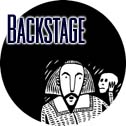
Comment
on this story
What:
Picasso at the Lapin Agile
When:
June 1-16 at 8 p.m., with no shows on Mondays and 2 p.m. matinees on June 10 and 16.
Where:
Clarence Brown Theatre
$5-$22. Call 974-5161.
|
|

Steve Martin's play takes great thinkers and gets them drunk
by Paige M. Travis
Who are these people we label geniuses? Are they born with a certain insight that sets them apart from the rest of us, or are they just blessed with good luck, timing and a bit of attention? History counts Pablo Picasso and Albert Einstein as geniuses, and rightly so. Picasso founded Cubism and influenced countless other master artists. Einstein changed the way we understand energy, matter, time and space, allowing for some of our most significant scientific strides. These two brains fall in line with Leonardo Da Vinci and Isaac Newton as two of the most important artists and scientists ever born.
But how were they different from their peers when they were 20-somethings coming up in the early 20th century? And how different is the genius who inspires an entire art movement from he who fathoms the rules of time and space?
These questions are addressed in the hilarious and heady Picasso at the Lapin Agile, the Clarence Brown Theatre's production premiering June 1. You don't need a biographer's knowledge of Picasso and Einstein to enjoy the play, just an open mind and a ticklish funny bone. The play was written by Steve Martin, the same "wild and crazy" stand-up comedian who co-wrote and starred in The Jerk and also wrote the screenplays for Roxanne and L.A. Story. The former philosophy major's first play was born while he was dodging the Hollywood limelight in the '90s. "Art and science, at their most creative levels, operate in the same way," Martin once told an interviewer. "The thinkers of art and science have creative, mystical insights that are not a formula."
Martin's own creation is mystical in its premise: a hypothetical meeting between Picasso and Einstein at the Lapin Agile, a bar in the funky Montmartre district of Paris, a popular hangout for artists. The year is 1904, when the two future world-shapers were 23 and 25, respectively. The play's director, Elizabeth Craven, explains that 1904 is significant for several reasons.
"We're encountering these people before they are mature or before they're tainted by the world," Craven says, including in her statement a character who appears late in the play identified in the credits only as The Visitor.
"We know that all of them became tainted by their interactions with the 20th century." The time period also has implications for us today, as we are also poised at the start of a new century. The play makes us consider how history will view our generations and who its geniuses are. "I think they're not people that we would expect. They're people that are hanging out in coffee shops," Craven predicts
Head of UT's MFA Acting program, Craven's past directing credits with CBT include more serious fare than the likes of Picasso, including last season's production of Hamlet with the Knoxville Symphony, The Bronte Cycle and The Grapes of Wrath.
"Comedy is the hardest, I think most directors would agree. But, that being said, I think all plays are plays that have their own way of speaking. I think it's a mistake to go into a comedy and say 'I'm going to approach this play differently because it's a comedy.' If the writing is good, it's going to come out." Craven's directing style lets the actors do their thing and the words work their magic. "My job, more than anything, is to select from what [the actors] do and to shape that in a way that [ensures] the story is clear."
On one level, Picasso (played by Seattle actor Tim Kniffin) and Einstein (UT graduate Jon Wesley Burnett) are just two smart guys, a little full of themselves, who try to one-up each other and impress the ladies at the bar one night. On another level, they are icons who symbolize the schools of art and science, where the two meet or collide. Craven shares Martin's belief that the two very different disciplines are rooted in a similar creativity. She owns a poster bearing a quote from Einstein: "Imagination is more important than knowledge."
"One wouldn't think that that would come from Einstein," she says. "But one of the things we know about the great theorists in science is that they were great observers of life. I think that's true of artists as well."
If this professional production (which also features longtime CBT favorites John Forrest Ferguson and Tony Cede�o) is as funny as the students' All Campus Theatre production in 1998, audiences are in for a real treat. Martin's play is rich with big ideas, crazy notions, inspired monologues and a few surprises. With a running time of 90 minutes, the play can be enjoyed then discussed over drinks with friends in the salon of your choice. Who knows, you might meet (or be) the next genius to change the world.

May 24, 2001 * Vol. 11, No. 21
© 2001 Metro Pulse
|